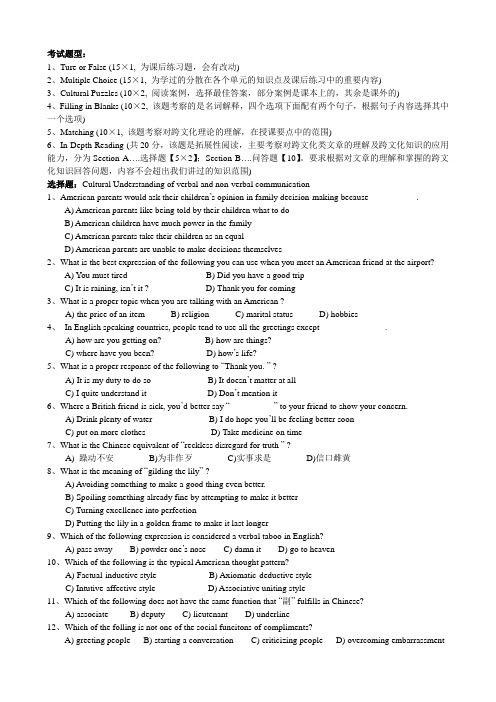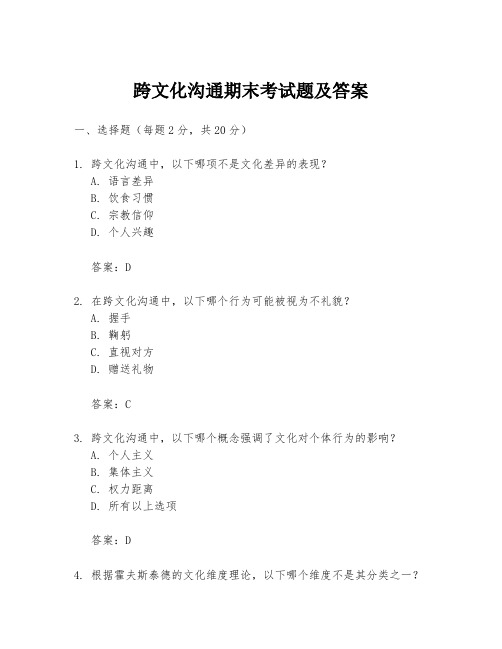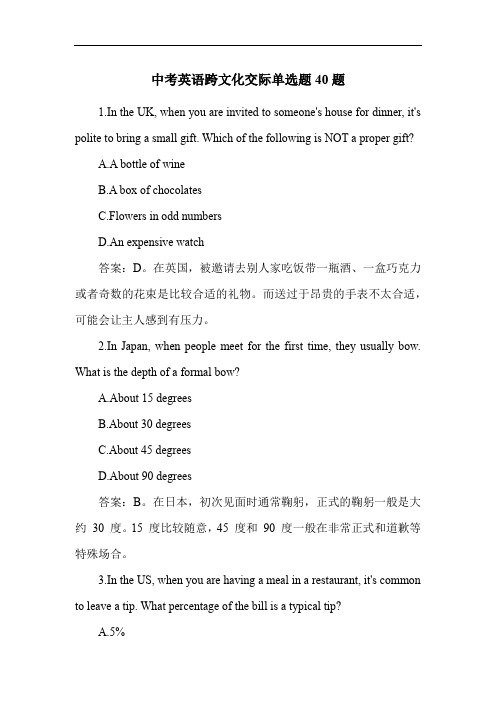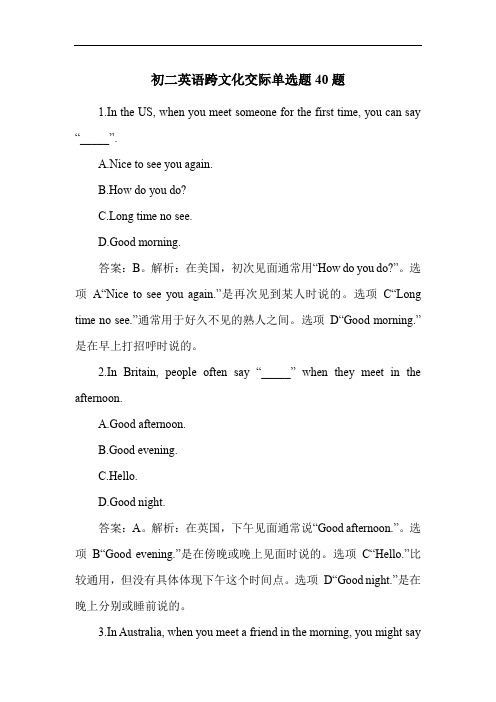跨文化交际选择题
跨文化交际选择题

跨文化交际选择题 1. When you talk with your friends about Picasso, Beethoven, you are talking about culture from ____ perspective. a. anthropologic b. intellectual c. social d. psychological 2. The dialogues at the United Nations, for example, would be termed _____. a. interracial communication b. interethnic communication c. international communication d. interpersonal communication 3. ____ is the process of putting an idea into a symbol. a. Decoding b. Channel c. Encoding d.
20. An American company that operates in Japan almost caused a disaster in the United States---Japanese relations by addressing 500 red Christmas cars to its Japanese Jointventure partner, since funeral notices are red in Japan. This case has reflected that each country has its art for ____. a. tipping b. greeting c. card exchange d. giving gift 21. In ____, the handshake is accompanied with a light kiss; even males kiss both cheeks after a handshake. a. the United States b. Saudi Arabia c. Russia d. France 22. ____ style focuses on the speaker and role relationships. People with such communication style stress high power distance. This style is popular in collectivist and highcontext culture. a. Contextual b. Personal c. Succinct d. Elaborate
跨文化交流考试试题

跨文化交流考试试题一、选择题(每题 5 分,共 25 分)1、以下哪个是跨文化交流中最容易导致误解的因素?()A 语言差异B 价值观差异C 生活习惯差异D 宗教信仰差异2、在日本,人们见面时通常会()A 握手B 拥抱C 鞠躬D 亲吻3、当与来自西方国家的人交流时,直接询问他们的年龄通常被认为是()A 礼貌的B 不礼貌的C 友好的D 正常的4、伊斯兰教的重要节日是()A 圣诞节B 开斋节C 复活节D 感恩节5、在跨文化交流中,“OK”这个手势在不同国家可能有不同的含义。
在以下哪个国家,这个手势被视为不礼貌或具有侮辱性?()A 美国B 日本C 巴西D 法国二、填空题(每题 5 分,共 25 分)1、跨文化交流中的“高语境文化”通常是指像_____、_____这样的国家,信息更多地蕴含在语境和关系中。
2、西方人的姓名通常是名字在前,姓氏在后,而中国人的姓名则是_____在前,_____在后。
3、世界上使用人数最多的语言是_____,使用范围最广的语言是_____。
4、印度人大多信仰_____教,而泰国人大多信仰_____教。
5、不同文化中对于颜色的象征意义有所不同,在中国,红色通常象征着_____和_____。
三、简答题(每题 10 分,共 30 分)1、请简要说明跨文化交流中文化休克的含义及表现。
答:文化休克是指一个人进入到一个与自己原有文化环境差异较大的新环境时,在一段时间内出现的焦虑、失落、困惑、无助等一系列心理和生理上的不适反应。
表现可能包括情绪低落、孤独感强烈、对新环境的排斥、难以适应新的生活方式和价值观、沟通障碍等。
2、举例说明在跨文化商务交流中,应该注意哪些礼仪方面的差异?答:在跨文化商务交流中,礼仪方面的差异有很多。
比如,在德国,商务会面时守时非常重要,如果迟到会被视为不尊重对方;而在一些拉丁美洲国家,时间观念相对较宽松。
在日本,交换名片时要用双手,并微微鞠躬,且要仔细阅读对方的名片;而在美国,交换名片可能相对随意。
高三英语跨文化交际单选题20题

高三英语跨文化交际单选题20题1. When you are invited to a dinner in Japan, it is polite to ________ before starting to eat.A. make a toastB. bow your headC. shake handsD. kiss on the cheek答案:B。
在日本文化中,用餐前低头鞠躬是礼貌的行为。
选项A“make a toast”常用于西方的社交场合;选项C“shake hands”在西方较为常见;选项D“kiss on the cheek”常见于一些欧洲国家。
而在日本,鞠躬是表示尊敬和礼貌的传统方式。
2. In the UK, if you are given a present, it is appropriate to ________.A. open it immediatelyB. wait until the next day to open itC. refuse it politelyD. give it back to the giver答案:A。
在英国文化中,收到礼物时立即打开是合适的。
选项B 等待第二天再打开不符合英国的习惯;选项C 礼貌地拒绝礼物是不恰当的;选项D 把礼物还给赠送者也是不合适的。
3. When meeting someone for the first time in the US, it is common to ________.A. hug each otherB. bow deeplyC. shake hands and look into each other's eyesD. kiss on the hand答案:C。
在美国,初次见面通常握手并直视对方的眼睛。
选项A 拥抱在熟人之间较为常见;选项B 深鞠躬不是美国的常见礼仪;选项D 吻手礼多见于欧洲的一些国家。
高中英语跨文化交际单选题50题

高中英语跨文化交际单选题50题1. In Japan, which of the following is considered a traditional staple food?A. PizzaB. SushiC. HamburgerD. Pasta答案:B。
本题主要考查日本的传统主食。
选项A“Pizza”是意大利的特色食品;选项C“Hamburger”是美国常见的快餐食品;选项D“Pasta”是意大利面,是意大利的特色。
而选项B“Sushi”是日本的传统美食,通常由米饭和生鱼片组成。
2. When it comes to French cuisine, which dish is famous worldwide?A. Fried ChickenB. SteakC. CroissantD. Noodles答案:B。
本题考查法国著名的美食。
选项A“Fried Chicken”是炸鸡,常见于美式快餐;选项C“Croissant”是牛角面包,是法国的特色面包,但不如牛排著名;选项D“Noodles”面条,不是法国的典型美食。
而选项B“Steak”牛排是法国美食中享誉世界的菜品。
3. Which of the following is a typical dessert in the UK?A. TiramisuB. CheesecakeC. Apple PieD. Mousse答案:C。
本题聚焦于英国的典型甜点。
选项A“Tiramisu”提拉米苏是意大利的甜点;选项B“Cheesecake”芝士蛋糕并非英国特有的;选项D“Mousse”慕斯在多个国家都有。
而选项C“Apple Pie”苹果派是英国常见的传统甜点。
4. In Italy, people often enjoy ______ for dinner.A. Peking Roast DuckB. SpaghettiC. CurryD. Dumplings答案:B。
《跨文化交际》题集

《跨文化交际》题集一、选择题(每题10分,共100分)1.跨文化交际主要研究的是:A. 不同国家之间的政治关系B. 不同文化背景的人们之间的交流与互动C. 国际经济的合作与发展D. 全球气候变化的影响2.在跨文化交际中,哪种行为可能被视为不尊重他人?A. 直视对方的眼睛以示真诚B. 在交谈中频繁点头表示赞同C. 在未经允许的情况下触摸他人的头部D. 礼貌地询问对方的个人生活3.“高语境文化”与“低语境文化”的区别在于:A. 沟通中直接信息的多少B. 人们使用语言的频率C. 社会习俗的复杂性D. 对时间的重视程度4.下列哪项不属于非言语交际的形式?A. 肢体语言B. 面部表情C. 语音语调D. 书面文字5.在一些文化中,沉默可能被视为:A. 同意的标志B. 思考的表示C. 不尊重的行为D. 沟通的一种方式6.“文化休克”通常发生在:A. 一个人长时间处于自己的文化中B. 一个人初次接触并适应新的文化环境时C. 一个人对某种文化有深入了解之后D. 一个人在不同文化之间频繁切换时7.下列哪项是跨文化交际中常见的挑战?A. 语言障碍B. 价值观差异C. 沟通风格的不同D. 以上都是8.在一些文化中,时间被视为一种:A. 可以随意支配的资源B. 必须严格遵守的规则C. 可以用来建立社会关系的工具D. 以上都有可能是,取决于具体的文化9.“面子”在跨文化交际中是一个重要的概念,它通常指的是:A. 一个人的社会地位B. 一个人的自尊心和荣誉感C. 一个人在外貌上的吸引力D. 一个人在经济上的实力10.下列哪项不是促进跨文化交际有效性的策略?A. 增强文化意识B. 发展跨文化沟通技巧C. 避免与不同文化背景的人交往D. 尊重并适应不同的文化习俗二、填空题(每题10分,共50分)1.在跨文化交际中,__________是指由于文化差异而导致的沟通障碍或误解。
2.__________文化强调直接、明确的沟通方式,而__________文化则更注重含蓄和间接的表达。
(完整word版)跨文化交际选择题

考试题型:1、Ture or False (15×1, 为课后练习题,会有改动)2、Multiple Choice (15×1, 为学过的分散在各个单元的知识点及课后练习中的重要内容)3、Cultural Puzzles (10×2, 阅读案例,选择最佳答案,部分案例是课本上的,其余是课外的)4、Filling in Blanks (10×2, 该题考察的是名词解释,四个选项下面配有两个句子,根据句子内容选择其中一个选项)5、Matching (10×1, 该题考察对跨文化理论的理解,在授课要点中的范围)6、In-Depth Reading (共20分,该题是拓展性阅读,主要考察对跨文化类文章的理解及跨文化知识的应用能力,分为Section A….选择题【5×2】;Section B….问答题【10】。
要求根据对文章的理解和掌握的跨文化知识回答问题,内容不会超出我们讲过的知识范围)选择题:Cultural Understanding of verbal and non-verbal communication1、American parents would ask their children’s opinion in family decision-making because___________.A) American parents like being told by their children what to doB) American children have much power in the familyC) American parents take their children as an equalD) American parents are unable to make decisions themselves2、What is the best expression of the following you can use when you meet an American friend at the airport?A) You must tired B) Did you have a good tripC) It is raining, isn’t it ? D) Thank you for coming3、What is a proper topic when you are talking with an American ?A) the price of an item B) religion C) marital status D) hobbies4、In English speaking countries, people tend to use all the greetings except_______________.A) how are you getting on? B) how are things?C) where have you been? D) how’s life?5、What is a proper response of the following to “Thank you. ” ?A) It is my duty to do so B) It doesn’t matter at allC) I quite understand it D) Don’t mention it6、Where a British friend is sick, you’d better say “__________” to your friend to show your concern.A) Drink plenty of water B) I do hope you’ll be feeling better soonC) put on more clothes D) Take medicine on time7、What is the Chinese equivalent of “reckless disregard for truth ” ?A) 躁动不安B)为非作歹C)实事求是D)信口雌黄8、What is the meaning of “gilding the lily” ?A) Avoiding something to make a good thing even better.B) Spoiling something already fine by attempting to make it betterC) Turning excellence into perfectionD) Putting the lily in a golden frame to make it last longer9、Which of the following expression is considered a verbal taboo in English?A) pass away B) powder one’s nose C) damn it D) go to heaven10、Which of the following is the typical American thought pattern?A) Factual-inductive style B) Axiomatic-deductive styleC) Intutive-affective style D) Associative uniting style11、Which of the following does not have the same function that “副” fulfills in Chinese?A) associate B) deputy C) lieutenant D) underline12、Which of the folling is not one of the social funcitons of compliments?A) greeting people B) starting a conversation C) criticizing people D) overcoming embarrassment13、What is the acceptable addressing of “Tom Smith” in American culture?A) Teacher Smith B) Mr. Tom C)Director Smith D) Professor Smith14、The word “dragon” is a word__________.A) with different associated meanings in Chinese B) without a counterpart in ChineseC) with the some primary meaning in Chinese D) with many more terms in Chinese15、When making an appointment with an American friend, which of the following expressions is the most appropriate one?A) I’m coming to see you this afternoon.B) You must stay at home waiting for me this afternoon.C) Could you come directly to my house this afternoon.D) I was wondering whether I could come round to visit you soemtime.16、Which of the following is not included in kinesics?A) posture B) stance C) body distance D) gesture17、Individualism has the following features except____________.A) strong family ties B)self-reliance C) freedom D) respect for individual rights18、M-time culture has the following features except__________.A) cutting time into bits B) taking dealines seriouslyC) scheduling one thing at a time D) more human-centered19、__________culture are typical P-time cultures.A) Latin American B) Northern American C) Western European D) Northern European20、In American culture, silence may be inerpreted as ___________.A) assertiveness B) thoughtfulness C) enthusiasm D)apathy21、Which culture tends to envelop each other in breath when talking?A) Arabian culture B) American culture C)British culture D) Chinese culture22、Which of the following is not included in chronemics?A) punctuality B) time orientation C) silence D) promptness23、What does the following gesture mean in some Latin American countries?A) money B) OK C) obscenity D) hostility24、Which of the following statement is untrue?A) The American “come here ” gesture could be seen as an insult in most Asian countries.B) In most Asian cultures, a gentle grip and an avoidance of direct eye contact is appropriate.C) Right hand is considered unclean in much of the Middle East and in parts of Indonesia.D) Pointing with the index finger is common in North American and Europe.25、When an American is parking his bicycle and the bicycle accidentally falls over, he feels embarrassed at his awkwardness, and his quite angered and humiliated when Chinese onlookers laugh.A) Don’t take it so seriously. B) It’s nothing.C) You are really clumsy. D) Such things can happen to any of us.。
跨文化交流考试试题及答案

跨文化交流考试试题及答案一、选择题1. 跨文化交流的定义是:A. 不同文化之间的交流B. 跨越地域界限的交流C. 多种交流方式的选择D. 不同语言之间的交流答案:A. 不同文化之间的交流2. 跨文化交流中最重要的因素是:A. 语言能力B. 文化背景C. 社交技巧D. 沟通方式答案:B. 文化背景3. 跨文化交流的挑战包括以下哪些?A. 语言障碍B. 文化差异C. 社交礼仪D. 打破隔阂答案:A. 语言障碍、B. 文化差异4. 在跨文化交流中,以下哪些行为是不恰当的?A. 尊重对方的文化习惯B. 使用简单明了的语言表达C. 批评对方的文化观念D. 遵守当地的社交礼仪答案:C. 批评对方的文化观念5. 跨文化交流的好处包括:A. 增进文化理解B. 缩小文化差异C. 促进国际合作D. 创造更多商机答案:A. 增进文化理解、C. 促进国际合作、D. 创造更多商机二、问答题1. 请简要说明跨文化交流的意义和价值。
跨文化交流具有重要的意义和价值。
首先,它可以增进不同文化之间的理解和尊重,消除误解和偏见,促进友好合作关系的建立。
其次,跨文化交流可以促进文化的多元发展和融合,丰富人们的思想和观念。
此外,跨文化交流有助于拓展商务和经济合作的机会,加强国际间的互利互惠关系。
总之,跨文化交流对于推动全球化进程、促进世界和平与繁荣具有重要的作用。
2. 请列举三种跨文化交流中常见的误解和解决方法。
常见误解:a. 语言障碍:不同语言之间存在的语言障碍常导致误解,解决办法可以是提前学习对方的语言,或者借助翻译工具和专业人士进行沟通。
b. 礼仪差异:不同文化间存在的社交礼仪差异容易导致误解,解决办法是提前了解对方的文化礼仪,尊重对方的习惯,并在交流中保持开放和灵活的态度。
c. 价值观冲突:不同文化之间的价值观存在差异,可能导致观念冲突和摩擦。
解决办法是理解对方的文化背景,尊重差异,以合作和共同利益为出发点,寻求共识和妥善处理分歧。
跨文化交际专业试题及答案

跨文化交际专业试题及答案一、选择题1. 跨文化交际中,以下哪个行为最可能被视为不礼貌?A. 直接注视对方B. 握手C. 鞠躬D. 保持微笑答案:A2. 在美国,人们通常在什么情况下会使用“please”?A. 要求别人做事B. 表达感谢C. 表达歉意D. 表达同意答案:A3. 在日本,以下哪种行为被认为是尊重的表现?A. 直接进入别人的办公室B. 敲门并等待允许C. 未经允许就坐下D. 直接打断别人说话答案:B4. 在阿拉伯文化中,握手时通常不包括以下哪个动作?A. 用右手B. 保持眼神接触C. 持续时间较长D. 同时用左手触碰对方答案:D5. 在中国文化中,赠送礼物时以下哪个行为是不恰当的?A. 包装礼物B. 赠送钟表C. 赠送书籍D. 赠送鲜花答案:B二、简答题1. 描述跨文化交际中非言语交流的重要性。
答案:非言语交流在跨文化交际中起着至关重要的作用,因为它可以传达情感、态度和文化背景。
非言语交流包括肢体语言、面部表情、眼神交流、声音的音调和节奏等。
不同的文化对这些非言语信号有不同的解读,因此理解和正确使用非言语交流对于跨文化沟通的成功至关重要。
2. 解释文化冲击是什么,并给出一个例子。
答案:文化冲击是指一个人在进入一个新文化环境时,由于文化差异而经历的心理和情感上的困惑、焦虑和不适。
例如,一个习惯于个人主义文化的西方人,当他第一次来到一个强调集体主义的亚洲国家时,可能会对那里的团队合作和群体决策感到不适应,从而经历文化冲击。
三、论述题1. 论述在国际商务环境中,了解和尊重不同文化的重要性。
答案:在国际商务环境中,了解和尊重不同文化对于建立和维护商业关系至关重要。
首先,了解不同文化可以帮助我们更好地理解商业伙伴的行为和期望,从而避免误解和冲突。
其次,尊重文化差异可以展示我们的开放性和包容性,这有助于建立信任和尊重,是长期合作关系的基石。
此外,跨文化交际能力也是全球化时代商务人士的重要技能,能够帮助企业在多元文化市场中取得成功。
跨文化交际试题及答案

跨文化交际试题及答案一、选择题(每题2分,共40分)1. 跨文化交际的定义是指:A. 不同国家和地区间的交际活动B. 不同民族和文化背景间的交际活动C. 同一文化内部的交际活动D. 不同语言之间的交际活动答案:B2. 文化差异会对跨文化交际产生以下哪种影响?A. 理解困难B. 语言障碍C. 价值观冲突D. 人际关系紧张答案:A、C3. 在跨文化交际中,以下哪种行为被认为是失礼的?A. 目光接触B. 握手问候C. 低头鞠躬D. 打招呼时用双手表示敬意答案:C4. 在中国文化中,以下哪种颜色象征喜庆和幸福?A. 黑色B. 红色C. 绿色D. 白色答案:B5. 在进行跨文化交际时,以下哪种策略是最有效的?A. 强调自己的文化优势B. 忽视文化差异C. 遵守对方的文化规范D. 强迫对方接受自己的文化观念答案:C二、简答题(每题10分,共30分)1. 请简要阐述跨文化交际的重要性以及其中存在的挑战。
答案:跨文化交际的重要性在于增进各国间的相互了解和友谊,推动跨国合作和发展。
然而,跨文化交际也面临着重重挑战,如语言沟通障碍、文化差异带来的不解和冲突,以及对他人观点和习俗的理解困难等。
2. 在国际商务谈判中,如何合理利用非语言交际手段?答案:在国际商务谈判中,非语言交际手段可以帮助加强沟通效果。
可以通过身体语言表达自信和诚意,比如坐姿、目光接触和手势运用等;可以通过服饰和礼仪来展示对对方文化的尊重;还可以通过图表和演示文稿等视觉媒介来辅助表达和说明。
3. 请简要解释文化冲突是如何产生的,并提出解决文化冲突的建议。
答案:文化冲突是由于不同文化之间的差异而产生的,当个体或群体面对不熟悉的文化规范和价值观时,可能会感到困惑和不满。
为解决文化冲突,建议应采取以下措施:学习和了解对方文化,加强跨文化交际能力;尊重差异,避免对他人价值观的评判和偏见;建立良好的沟通渠道,积极解释自己的观点并倾听对方的意见;寻求共同利益和双赢的解决方案。
高三英语跨文化交际单选题40题

高三英语跨文化交际单选题40题1.In the United States, when you are invited to someone's home for dinner, it is polite to bring a small gift. What is NOT an appropriate gift?A.A bottle of wineB.FlowersC.A set of knivesD.A box of chocolates答案:C。
在美国文化中,送刀被认为是不吉利的。
A 选项一瓶酒、B 选项花、D 选项一盒巧克力都是比较合适的礼物。
2.In Japan, when you receive a gift, what is the proper response?A.Open it immediately and express your excitement.B.Open it later in private.C.Don't open it at all.D.Throw it away.答案:B。
在日本文化中,收到礼物后通常会在之后私下打开,而不是立即打开或不打开甚至扔掉。
3.In Britain, when you meet someone for the first time, what is a common topic of conversation?A.PoliticsB.ReligionC.The weatherD.Personal income答案:C。
在英国,人们初次见面通常会谈论天气,而避免谈论政治、宗教和个人收入等比较敏感的话题。
4.In China, when you are having a meal with elders, what should you do?A.Start eating before the elders.e chopsticks to point at others.C.Fill the elders' cups first.D.Talk loudly.答案:C。
跨文化交际概论题集

跨文化交际概论题集一、选择题1. 跨文化交流的主要目的是()A. 传播本国文化B. 了解和尊重不同文化C. 实现经济利益D. 推广语言答案:B2. 跨文化交流的定义强调()A. 不同种族之间的交流B. 不同文化背景人们的互动C. 国际间的政治交流D. 语言的转换答案:B3. 跨文化交流的重要性体现在()A. 促进全球经济发展B. 增进文化理解与和谐C. 加强国际政治合作D. 以上都是答案:D4. 下列哪项不属于跨文化交流的要素()A. 语言B. 价值观C. 地理位置D. 风俗习惯答案:C5. 跨文化交流对个人的影响包括()A. 提升文化敏感度B. 拓宽思维方式C. 增强适应能力D. 以上都是答案:D6. 跨文化交流的意义在于()A. 消除文化差异B. 促进文化融合C. 保护本土文化D. 以上都不是答案:B7. 以下关于跨文化交流的描述,正确的是()A. 只涉及语言的交流B. 是一种单向的信息传递C. 包括文化的相互影响和适应D. 不需要考虑文化背景答案:C8. 跨文化交流的定义涵盖了()A. 不同国家之间的交流B. 不同民族之间的交流C. 不同文化群体之间的交流D. 以上都是答案:D9. 跨文化交流的重要性在于它能够()A. 提高国际竞争力B. 丰富个人经历C. 促进文化创新D. 以上都是答案:D10. 下列哪项不是跨文化交流的挑战()A. 语言障碍B. 文化偏见C. 相似的文化背景D. 价值观差异答案:C11. 跨文化交流有助于()A. 培养全球视野B. 增强民族自豪感C. 推广本国文化D. 以上都是答案:D12. 跨文化交流的定义不包括()A. 文化的冲突与对抗B. 文化的理解与尊重C. 信息的传递与共享D. 人际关系的建立答案:A13. 跨文化交流对社会的影响包括()A. 促进社会进步B. 增加文化多样性C. 加强社会凝聚力D. 以上都是答案:D14. 以下关于跨文化交流重要性的说法,错误的是()A. 可以避免文化冲突B. 有助于推动文化发展C. 能够促进国际合作D. 是全球化的必然趋势答案:A15. 跨文化交流的关键是()A. 掌握多种语言B. 了解不同文化的特点C. 拥有丰富的知识D. 具备良好的沟通技巧答案:B16. 跨文化交流的定义涉及到()A. 文化的传承B. 文化的变迁C. 文化的比较D. 以上都是答案:D17. 跨文化交流的重要意义在于()A. 提高文化认同感B. 促进文化交流与合作C. 保护文化遗产D. 以上都是答案:D18. 下列哪项是跨文化交流的积极作用()A. 减少文化误解B. 增进文化认同C. 促进文化发展D. 以上都是答案:D19. 跨文化交流的定义中强调的是()A. 文化的共性B. 文化的差异C. 文化的交流与融合D. 以上都是答案:D20. 跨文化交流的重要性在全球化背景下变得()A. 更加突出B. 逐渐减弱C. 没有变化D. 难以确定答案:A21. 以下哪种文化差异属于宗教信仰的差异?()A. 对神灵的崇拜方式不同B. 对建筑风格的喜好不同C. 对艺术形式的欣赏角度不同D. 对节日庆祝方式的不同答案:A22. 文化差异中的审美观念差异表现在()A. 对音乐风格的偏好不同B. 对服装款式的选择不同C. 对自然景观的审美标准不同D. 以上都是答案:D23. 教育体系的差异属于文化差异的哪种类型?()A. 教育目标的不同B. 教学方法的不同C. 教育资源的分配不同D. 以上都是答案:D24. 家庭观念的差异包括以下哪些方面?()A. 家庭成员的角色和责任不同B. 家庭关系的重视程度不同C. 家庭教育的方式不同D. 以上都是答案:D25. 以下哪种文化差异属于思维方式的差异?()A. 对逻辑推理的重视程度不同B. 对直觉和经验的依赖程度不同C. 对问题解决的方法不同D. 以上都是答案:D26. 文化差异中的饮食文化差异包括()A. 食物种类的不同B. 烹饪方式的不同C. 用餐礼仪的不同D. 以上都是答案:D27. 艺术表现形式的差异属于文化差异的哪种类型?()A. 绘画风格的不同B. 文学作品的主题和风格不同C. 音乐节奏和旋律的不同D. 以上都是答案:D28. 社会规范的差异包括以下哪些方面?()A. 道德准则的不同B. 法律制度的不同C. 社交礼仪的不同D. 以上都是答案:D29. 以下哪种文化差异属于历史传统的差异?()A. 对历史事件的评价不同B. 对传统文化的传承方式不同C. 对历史人物的纪念方式不同D. 以上都是答案:D30. 文化差异中的语言文字差异包括()A. 文字形式的不同B. 词汇含义的不同C. 语法结构的不同D. 以上都是答案:D31. 价值观的差异可以体现在()A. 对成功的定义不同B. 对幸福的追求不同C. 对人际关系的重视程度不同D. 以上都是答案:D32. 审美标准的差异包括以下哪些方面?()A. 对美的定义不同B. 对艺术作品的评价不同C. 对自然景观的欣赏角度不同D. 以上都是答案:D33. 宗教仪式的差异属于文化差异的哪种类型?()A. 宗教活动的形式不同B. 宗教信仰的对象不同C. 宗教教义的解释不同D. 以上都是答案:D34. 文化差异中的时间观念差异表现在()A. 对时间的重视程度不同B. 时间安排的方式不同C. 对准时的理解不同D. 以上都是答案:D35. 空间观念的差异包括以下哪些方面?()A. 对个人空间的需求不同B. 对建筑布局的喜好不同C. 对地理位置的重视程度不同D. 以上都是答案:D36. 以下哪种文化差异属于社会结构的差异?()A. 社会组织形式的不同B. 社会阶层的划分方式不同C. 社会权力分配的不同D. 以上都是答案:D37. 文化差异中的性别观念差异包括()A. 对男女角色的定义不同B. 对性别平等的认知不同C. 对性别行为的规范不同D. 以上都是答案:D38. 艺术创作动机的差异属于文化差异的哪种类型?()A. 对艺术表达的目的不同B. 对艺术创新的追求不同C. 对艺术传统的尊重程度不同D. 以上都是答案:D39. 以下哪种文化差异属于民俗习惯的差异?()A. 对节日庆祝的方式不同B. 对婚礼仪式的重视程度不同C. 对民间传说的传承方式不同D. 以上都是答案:D40. 文化差异中的教育观念差异包括()A. 对教育目的的理解不同B. 对教育方法的选择不同C. 对教育资源的分配不同D. 以上都是答案:D41. 文化休克通常发生在()A. 初次进入不同文化环境时B. 长期生活在同一文化环境中C. 与不同文化背景的人交流时D. 学习其他文化知识时答案:A42. 文化休克的主要表现包括()A. 焦虑、孤独、困惑B. 兴奋、好奇、激动C. 平静、适应、融入D. 自信、乐观、开朗答案:A43. 以下哪种情况可能导致文化休克加剧?()A. 积极学习当地语言和文化B. 与当地人保持密切联系C. 固执地坚持自己的文化观念D. 尝试适应新的生活方式答案:C44. 文化适应的过程通常包括()A. 接触、冲突、调整、适应B. 了解、接受、融入、认同C. 观察、模仿、学习、创新D. 排斥、抵制、妥协、适应答案:A45. 当面临文化休克时,以下哪种应对方式是积极的?()A. 逃避现实,拒绝与外界接触B. 抱怨和指责当地文化C. 保持开放的心态,努力适应D. 坚持自己的文化传统,不做改变答案:C46. 文化适应的阶段中,“蜜月期”的特点是()A. 对新文化充满好奇和兴奋B. 开始感受到文化差异带来的压力C. 逐渐适应新文化,融入当地生活D. 对原文化产生强烈的怀念答案:A47. 文化休克的程度可能受到()的影响。
跨文化沟通期末考试题及答案

跨文化沟通期末考试题及答案一、选择题(每题2分,共20分)1. 跨文化沟通中,以下哪项不是文化差异的表现?A. 语言差异B. 饮食习惯C. 宗教信仰D. 个人兴趣答案:D2. 在跨文化沟通中,以下哪个行为可能被视为不礼貌?A. 握手B. 鞠躬C. 直视对方D. 赠送礼物答案:C3. 跨文化沟通中,以下哪个概念强调了文化对个体行为的影响?A. 个人主义B. 集体主义C. 权力距离D. 所有以上选项答案:D4. 根据霍夫斯泰德的文化维度理论,以下哪个维度不是其分类之一?A. 个人主义与集体主义B. 男性化与女性化C. 长幼有序D. 权力距离答案:C5. 在跨文化沟通中,以下哪个策略不是有效的沟通策略?A. 保持开放心态B. 避免使用肢体语言C. 尊重文化差异D. 积极倾听答案:B二、填空题(每空1分,共10分)6. 在跨文化沟通中,_________是指在不同文化背景下,人们对于同一事件或行为的不同理解和解释。
答案:文化相对主义7. 跨文化沟通的障碍之一是_________,即对其他文化持有偏见或刻板印象。
答案:文化偏见8. 跨文化沟通中,_________是指在不同文化间进行有效交流的能力。
答案:跨文化能力9. 跨文化沟通中,_________是指在不同文化背景下,人们对于时间的理解和使用方式。
答案:时间观念10. 跨文化沟通中,_________是指在不同文化背景下,人们对于空间的理解和使用方式。
答案:空间观念三、简答题(每题10分,共20分)11. 简述跨文化沟通中的语言障碍及其克服方法。
答案:语言障碍包括语言差异、非言语沟通差异等。
克服方法包括学习对方的语言、使用简单明了的表达、利用肢体语言辅助沟通、寻求翻译帮助等。
12. 描述跨文化沟通中的文化适应过程。
答案:文化适应过程通常包括四个阶段:蜜月期、文化休克期、调整期和融入期。
在蜜月期,人们对于新文化充满好奇和兴奋;文化休克期则可能感到困惑和挫败;调整期是逐渐适应新文化的过程;最后,在融入期,人们能够自如地在新文化中生活和工作。
跨文化交际比赛试题答案

跨文化交际比赛试题答案一、选择题1. 跨文化交际中,以下哪种行为最可能引起误解?A. 使用简单直白的语言B. 避免使用手势C. 尊重对方的文化习俗D. 主动学习对方的语言答案:B2. 在不同文化背景下,以下哪种沟通方式被认为是最直接有效的?A. 书面沟通B. 口头沟通C. 非言语沟通D. 电子沟通答案:C3. 跨文化团队合作中,最关键的成功因素是什么?A. 团队成员的专业技能B. 团队成员的语言能力C. 团队成员的文化适应性D. 团队成员的领导能力答案:C4. 以下哪个选项不是跨文化交际中的障碍?A. 语言差异B. 价值观冲突C. 饮食习惯D. 管理风格差异答案:C5. 在跨文化交流中,以下哪种策略最有助于建立信任?A. 强调自己文化的优势B. 避免谈论敏感话题C. 积极倾听并尊重对方观点D. 坚持己见,不轻易妥协答案:C二、简答题1. 描述跨文化交际中“文化冲击”的概念,并给出应对策略。
文化冲击是指个体在进入一个文化环境与自己原有文化环境差异较大时,所产生的心理和情绪上的不适感。
应对策略包括:提前了解目标文化的基本知识,保持开放和尊重的态度,建立支持网络,以及逐步适应新环境。
2. 举例说明非言语交际在跨文化交际中的作用。
非言语交际包括肢体语言、面部表情、眼神交流等。
例如,在一些文化中,直接的眼神交流可能被视为自信和诚实的表现,而在另一些文化中,则可能被视为不尊重或挑衅的行为。
了解并适应这些差异有助于更有效的沟通。
3. 讨论文化相对主义在跨文化交际中的意义。
文化相对主义强调尊重和接受不同文化的价值和行为准则。
在跨文化交际中,文化相对主义有助于减少偏见和误解,促进相互理解和尊重,从而建立更加和谐的跨文化关系。
三、论述题1. 分析全球化背景下,跨文化交际能力对个人和组织的重要性。
全球化使得不同文化背景的人们交流更加频繁,无论是个人还是组织,都需要具备跨文化交际能力以适应多元文化环境。
对个人而言,这种能力有助于在国际舞台上建立联系、拓展视野、提升竞争力。
高一英语学科跨文化交际差异单选题50题

高一英语学科跨文化交际差异单选题50题1.In the United States, when you meet someone for the first time, you might say_____.A.How are you doing?B.How old are you?C.What's your salary?D.Where are you going?答案:A。
在美国,初次见面通常会用“How are you doing?”来问候,这是比较常见和礼貌的方式。
选项B“问年龄”、选项C“问薪水”、选项D“问去哪里”在很多西方文化中都被认为是比较私人的问题,不适合作为初次见面的问候语。
2.In Japan, people often bow when they greet each other. If you are greeted by a Japanese person, what is an appropriate response?_____A.Shake hands firmly.B.Bow back slightly.C.Hug the person.D.Kiss on the cheek.答案:B。
在日本,鞠躬是常见的问候方式,当被日本人问候时,回以轻微的鞠躬是比较恰当的回应。
选项A“用力握手”、选项C“拥抱”、选项D“亲吻脸颊”都不是日本文化中常见的问候回应方式。
3.In France, when meeting friends, it's common to_____.A.give a high fiveB.kiss on both cheeksC.nod and smileD.shake hands and look down答案:B。
在法国,朋友见面时通常会亲吻两边脸颊。
选项A“击掌”不是法国常见的问候方式;选项C“点头微笑”比较普通,不是法国特色的问候;选项D“握手并低头”也不符合法国的问候习惯。
中考英语跨文化交际单选题40题

中考英语跨文化交际单选题40题1.In the UK, when you are invited to someone's house for dinner, it's polite to bring a small gift. Which of the following is NOT a proper gift?A.A bottle of wineB.A box of chocolatesC.Flowers in odd numbersD.An expensive watch答案:D。
在英国,被邀请去别人家吃饭带一瓶酒、一盒巧克力或者奇数的花束是比较合适的礼物。
而送过于昂贵的手表不太合适,可能会让主人感到有压力。
2.In Japan, when people meet for the first time, they usually bow. What is the depth of a formal bow?A.About 15 degreesB.About 30 degreesC.About 45 degreesD.About 90 degrees答案:B。
在日本,初次见面时通常鞠躬,正式的鞠躬一般是大约30 度。
15 度比较随意,45 度和90 度一般在非常正式和道歉等特殊场合。
3.In the US, when you are having a meal in a restaurant, it's common to leave a tip. What percentage of the bill is a typical tip?A.5%B.10%C.15%D.20%答案:C。
在美国,在餐厅用餐通常要给小费,一般是账单的15%左右。
5%太少,10%有点少,20%比较多但也有情况会给到这么多。
4.In France, when you are having a conversation with someone, it's considered rude to do what?A.Interrupt themB.Look them in the eyeC.Talk loudlye your hands a lot答案:A。
高一英语跨文化交际策略单选题40题

高一英语跨文化交际策略单选题40题1.In some Western countries, nodding the head means “yes”, while in some Asian countries, shaking the head means “yes”. In India, people often shake their heads to show ___.A.agreementB.disagreementC.uncertaintyD.impatience答案:A。
在印度,人们摇头通常表示同意。
选项B“disagreement”是不同意;选项C“uncertainty”是不确定;选项D“impatience”是不耐烦。
2.In the United States, a thumbs-up sign usually means ___.A.approvalB.requestC.warningD.disapproval答案:A。
在美国,竖起大拇指通常表示赞成、认可。
选项B“request”是请求;选项C“warning”是警告;选项D“disapproval”是不赞成。
3.In Japan, bowing is a common form of greeting. A deep bow usually indicates ___.A.respectB.familiarityC.indifferenceD.disrespect答案:A。
在日本,鞠躬是常见的问候方式。
深深鞠躬通常表示尊敬。
选项B“familiarity”是熟悉;选项C“indifference”是冷漠;选项D“disrespect”是不尊敬。
4.In some Middle Eastern countries, pointing with the index finger is considered ___.A.politeB.rudeC.friendlyD.formal答案:B。
初二英语跨文化交际单选题40题

初二英语跨文化交际单选题40题1.In the US, when you meet someone for the first time, you can say “_____”.A.Nice to see you again.B.How do you do?C.Long time no see.D.Good morning.答案:B。
解析:在美国,初次见面通常用“How do you do?”。
选项A“Nice to see you again.”是再次见到某人时说的。
选项C“Long time no see.”通常用于好久不见的熟人之间。
选项D“Good morning.”是在早上打招呼时说的。
2.In Britain, people often say “_____” when they meet in the afternoon.A.Good afternoon.B.Good evening.C.Hello.D.Good night.答案:A。
解析:在英国,下午见面通常说“Good afternoon.”。
选项B“Good evening.”是在傍晚或晚上见面时说的。
选项C“Hello.”比较通用,但没有具体体现下午这个时间点。
选项D“Good night.”是在晚上分别或睡前说的。
3.In Australia, when you meet a friend in the morning, you might say“_____”.A.Good day.B.Good morning.C.Hi.D.How are you?答案:B。
解析:在澳大利亚,早上见面通常说“Good morning.”。
选项A“Good day.”比较不常用。
选项C“Hi.”比较随意,没有体现早上这个时间点。
选项D“How are you?”不是专门用于早上的问候语。
4.In Canada, when you meet someone you haven't seen for a while, you can say “_____”.A.How's it going?B.What's up?C.Glad to see you.D.Hello.答案:C。
中考英语跨文化交际技巧单选题60题

中考英语跨文化交际技巧单选题60题1.In the United States, when you are invited to someone's home for dinner, it is polite to________.A.arrive earlyB.arrive on timeC.arrive lateD.arrive very late答案:B。
在美国,被邀请去别人家吃晚餐时,准时到达是礼貌的。
提前到达可能会让主人觉得没有准备好,迟到或很晚到达会被认为不礼貌。
2.In Japan, when you receive a gift, it is proper to________.A.open it immediatelyB.open it laterC.never open itD.throw it away答案:B。
在日本,收到礼物时通常会在之后打开,而不是立即打开,立即打开被认为是不礼貌的。
3.In Britain, when you have a meal in a restaurant, it is common to________.A.tip a large amountB.tip a small amountC.never tipD.tip the waiter with food答案:B。
在英国,在餐厅用餐后通常会给少量小费。
给大量小费比较少见,不给小费不太礼貌,用食物当小费是不合适的。
4.In China, when you meet someone for the first time, it is polite to________.A.shake hands firmlyB.hug tightlyC.kiss on the cheekD.bow deeply答案:A。
在中国,初次见面时通常会有力地握手。
紧紧拥抱、亲吻脸颊一般用于亲密的人之间,深深鞠躬不太常见。
六年级英语跨文化交际单选题40题

六年级英语跨文化交际单选题40题1.In the UK, when you are invited to someone's house, it's polite to bring a small gift. What is NOT a proper gift?A.A box of chocolatesB.A bunch of flowersC.A bottle of wineD.A pet dog答案:D。
在英国,被邀请去别人家时,带一盒巧克力、一束花或者一瓶酒都是比较合适的礼物。
而带宠物狗不是一个恰当的礼物选择,因为主人可能没有做好接待宠物的准备,而且可能对某些人来说会带来不便。
2.In the US, when you meet someone for the first time, what is a common greeting?A.Kissing on the cheekB.Bowing deeplyC.Shaking handsD.Hugging tightly答案:C。
在美国,初次见面时通常是握手问候。
亲吻脸颊一般在比较亲密的朋友或家人之间;深鞠躬不是美国常见的初次见面问候方式;紧紧拥抱也通常不是初次见面的问候方式。
3.In Japan, when you enter a traditional Japanese house, what should you do?A.Keep your shoes onB.Take off your shoesC.Wear slippers providedD.Wear any shoes you like答案:B。
在日本,进入传统的日式房屋时应该脱鞋。
这是日本的传统礼仪习惯。
4.In France, when having a meal in a restaurant, it's considered polite to do what?A.Eat quicklyB.Talk loudlye a fork and knife properlyD.Put elbows on the table答案:C。
五年级英语跨文化交际单选题40题

五年级英语跨文化交际单选题40题1.In the UK,people usually greet each other by saying_____.A.Hello!How are you?B.Good morning!C.Nice to see you!D.Hi!What's up?答案:A。
在英国,人们通常用“Hello!How are you?”来互相问候。
选项B“Good morning!”一般用于早上的问候;选项C“Nice to see you!”通常用于见面打招呼,但不是日常最常用的问候方式;选项D“What's up?”比较随意,不是最普遍的日常问候方式。
2.In the US,people often start a conversation with_____.A.How are you doing?B.Good afternoon!C.Hi!Long time no see.D.Nice day,isn't it?答案:A。
在美国,人们经常用“How are you doing?”来开始对话。
选项B“Good afternoon!”是下午的特定问候;选项C“Hi!Long time no see.”虽然也可以用于打招呼,但不是最常见的开始对话的方式;选项D“Nice day,isn't it?”是谈论天气的方式,不是日常最常用的开始对话的问候方式。
3.In Australia,people might say_____to greet each other.A.G'day!B.Hello!How's it going?C.Good evening!D.Nice to meet you!答案:A。
在澳大利亚,人们可能会说“G'day!”来互相问候。
选项B“How's it going?”比较随意,但不是澳大利亚最具代表性的日常问候;选项C“Good evening!”是晚上的特定问候;选项D“Nice to meet you!”通常用于初次见面,不是日常问候方式。
- 1、下载文档前请自行甄别文档内容的完整性,平台不提供额外的编辑、内容补充、找答案等附加服务。
- 2、"仅部分预览"的文档,不可在线预览部分如存在完整性等问题,可反馈申请退款(可完整预览的文档不适用该条件!)。
- 3、如文档侵犯您的权益,请联系客服反馈,我们会尽快为您处理(人工客服工作时间:9:00-18:30)。
a. interracial communication b. interethnic communication c. international communication d. interpersonal communication 9. The ____ is the person with an idea he or she desires to communicate. a. message b. context c. source d. feedback 10. ____ refers to the exchange of messages between members of the dominant culture within a country.
20. An American company that operates in Japan almost caused a disaster in the United States---Japanese relations by addressing 500 red Christmas cars to its Japanese Jointventure partner, since funeral notices are red in Japan. This case has reflected that each country has its art for ____. a. tipping b. greeting c. card exchange d. giving gift 21. In ____, the handshake is accompanied with a light kiss; even males kiss both cheeks after a handshake. a. the United States b. Saudi Arabia c. Russia d. France 22. ____ style focuses on the speaker and role relationships. People with such communication style stress high power distance. This style is popular in collectivist and highcontext culture. a. Contextual b. Personal c. Succinct d. Elaborate
14. Mr. Wang, a Chinese immigrant in U.S., has adapted himself so well to American culture that he gradually lost his Chinese cultural identity. This process is called ____. a. separation and segregation b. integration c. assimilation d. marginalization 15. Liming, a Chinese student, just began his study in a university in the United States. In his first week in U.S, he thought everything was new and exciting, and he enjoyed himself a lot. Liming is in ____ stage of culture shock. a. honeymoon b. crisis c. reintegration d. gradual adjustment (culture shock:文化冲击(突然处于一个与前大不相同的社会和 文化环境中因而感到困惑、忧虑、烦恼的心情) 16. ____ refers to maintaining one’s original culture and not participating in the new culture. a. Separation and segregation b. Marginalization c. Assimilation d. Integration
5. ____ refers to the response of a receiver to a sender’s message. a. Receiver b. Decoding c. Encoding d. Feedback 6. Definitions of communication from many Asian countries stress ____, which is most notable in cultures with a Confucian tradition. a. harmony b. exchanging communication c. respect d. instrumental function 7. Communication doesn’t occur in isolation or in a vacuum, but rather it takes place in a physical and a social context; both establish the rules that govern the interaction. It reflects
26. ____ refers to the traumatic experience that an individual may encounter when entering a different society. a. Dissimilation b. Assimilation c. Integration d. Culture shock 27. ____ is behaviors such as gestures, body movements, facial expressions, and eye contact. a. Chromatics b. Olfactics c. Haptics d. Kinestics 28. While writing business messages, ____ is usually the first step. a. prediction b. selection c. analysis d. planning
17. ____ refers to an individual’s learning and adopting the norms and values of the new host culture. a. Acculturation b. Deculturation c. Marginalization d. Integration 18. ____ is the socialization process you go through to adapt to your society. a. Deculturation b. Acculturation c. Assimilation d. Enculturation 19. ____ takes place when individuals become an integral part of the new culture while maintaining their cultural integrity. a. Culture shock b. Integration c. Cultural identity d. Acculturation
23. ____ refers to some words or actions that are avoided by a particular group of people, or in certain culture for religious or social reasons. a. Euphemism b. Taboo c. Argot d. Dialect 24. The ____ refers to the ability to understand and adapt to the target culture; in another word, it refers to the sensitivity to cultural diversity, i.e., the ability to behave in an appropriate way and to regulate one’s communication and interaction according to the context. a. intercultural competence b. social competence c. communication competence d. cultural competence 25. ____ refers to losing one’s cultural identity and
11. ____ occurs when the sender and the receiver exchanging messages are from different races with different physical characteristics.
a. Interethnic communication b. Interracial communication c. Intracultural communication d. intercultural communication 12. ____ refers to one’s sense of belonging to a particular culture or ethnic group. a. Cultural identity b. Cultural value c. Cultural norm d. Subculture 13. ____ is the environment in which the communication takes place and which helps define the communication.
